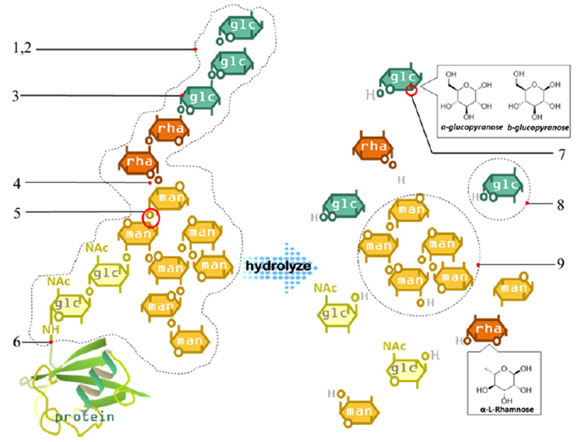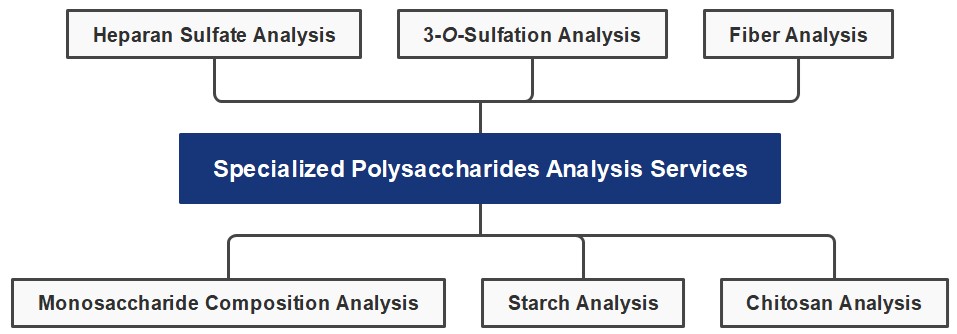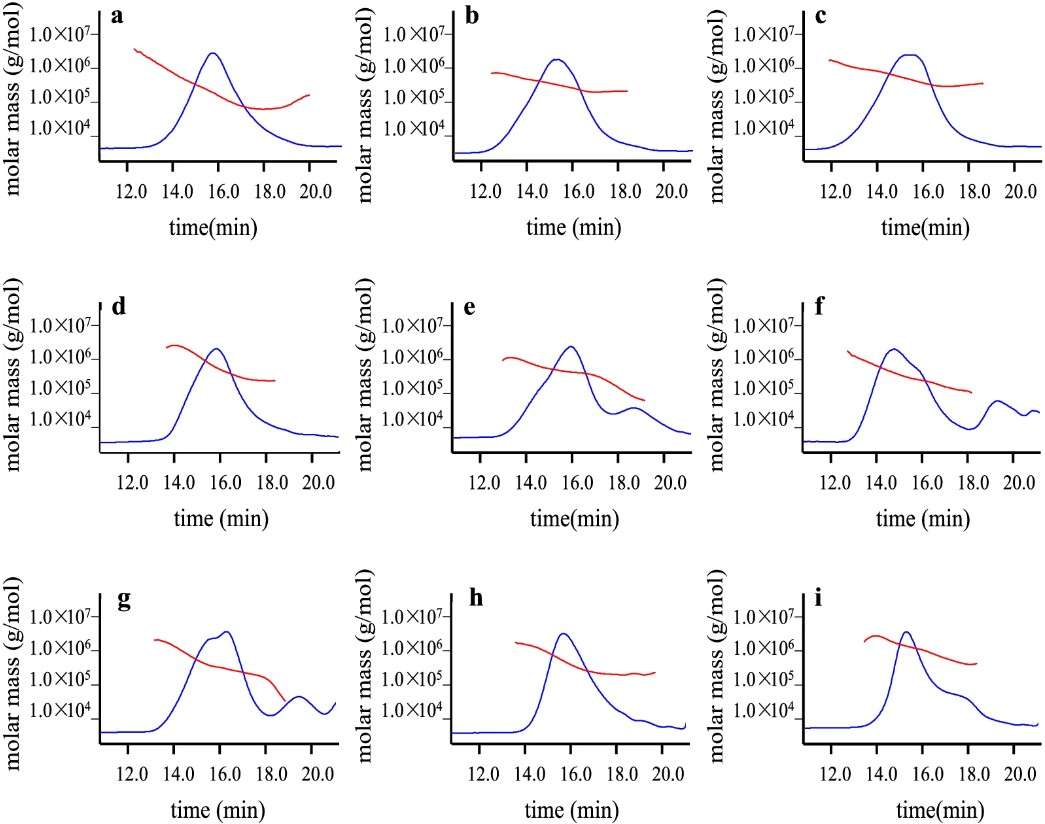Confirming the identity of polysaccharides is becoming increasingly more important in the pharmaceutical, food, and specialty chemical industries. Creative Biolabs has established a powerful platform with a range of advanced technologies for polysaccharides analysis. We are confident in solving problems in polysaccharides analysis for our global customers.
Introduction of Polysaccharide
Polysaccharides are often considered as a food source and structural building block. Their biological roles in many ways have been overlooked in the past due to their unique complexity. Nevertheless, over the last decade, researchers have increasingly paid their attention toward understanding the role of polysaccharides in normal cellular function and in disease, which opened up new research fronts in terms of probing glycans as targets in the design and development of novel drugs or new therapies for infectious disease, neurological disease, cancer, and metabolic disorders. Indeed, polysaccharides have been considered as novel important functional components for their significant biological activities, such as antioxidation, immune potentiation, antitumor, antiinflammation, and blood sugar reduction. The biological activities of polysaccharides are closely correlated to their physicochemical properties. Therefore, the characterization of polysaccharides is necessary.
 Fig.1 Analysis of the primary structure of polysaccharides.1, 3
Fig.1 Analysis of the primary structure of polysaccharides.1, 3
Introduction of Polysaccharides Analysis
Polysaccharides are very intricate complex, so the process of analysis is also manifold. Generally, monosaccharides composition and their linkage positions and sequence should be determined first. Then, the anomeric configuration of linkages, the ring size (furanose or pyranose), the absolute configuration (D or L), and any other substituents present should be identified. Up to now, there is no single method that can complete polysaccharide alone. Usually, separation and extraction techniques, component analysis, methylation analysis, glycosidic hydrolysis, mass spectrometry (MS) and nuclear magnetic resonance (NMR) spectroscopy are required to determine the fine structure while size exclusion chromatography (SEC) coupled with light scattering (LS) detectors to determine the molecular size distribution.
Polysaccharides Analysis Services at Creative Biolabs
Due to the intricate condition of polysaccharides, there is no single method capable of determining the total exact structure. Based on our top technology platforms, Creative Biolabs provides a series of polysaccharides analysis services to meet customers' specific requirements. Our seasoned scientists are extremely professional in the determination of molecular weight and structure of polysaccharides. Particularly, we will give you a satisfactory result based on our powerful technology platform.
-
Molecular Weight Determination
SEC is used routinely to study the molecular weight and structural characteristics of macromolecules, and this technology is useful for polysaccharide characterization. It is a sophisticated technology available to provide information about the whole molecular weight distribution. SEC remains a popular molecular determination and separation method due to its versatility, the wide range of matrices commercially available, and the mild conditions of operation. One of the major advantages of SEC is that separation can be performed under conditions specifically designed to maintain the stability and activity of the molecule of interest without compromising resolution. With years of experience in SEC, Creative Biolabs is devoted to meeting any requirements of customers.
From NMR experiments of the native sample, structural features including the presence of deoxy or amino-deoxy sugars, the configuration of the glycosidic linkages and the ring size of the sugar residues, and the presence of non-sugar constituents, may be deduced. Due to less complexity of the spectra and better resolution, NMR has been widely applied to fractions obtained from partial degradation. MS methods may be applied to polymers as the matrix assisted laser desorption/ionization time-of-flight mass spectrometry (MALDI-TOF MS) or pyrolysis-direct chemical ionization-MS. MS methods may also be applied to isolated oligomers or even the oligomeric mixtures. Structure information can be improved by recording the daughter ion spectra of single ions (Tandem-MS). Finally, the sequence of a polysaccharide chain could be reconstructed from the information gathered. Creative Biolabs has an excellent technical team and systematic technical platform to perfectly solve your trouble.
Specialized Polysaccharides Analysis Project at Creative Biolabs
Creative Biolabs has built a mature polysaccharide analysis platform, and our professional technical team provides reliable heparan sulfate (HS), 3-O-sulfation analysis, and fiber analysis services.
HS is a linear sulfated polysaccharide molecule distributed on the cell surface and extracellular matrix. We provide HS analysis services for different samples, including cell culture supernatant, tissue, plasma/serum, urine, drug samples, and other sample types. We use a variety of analysis technologies together to provide complete and comprehensive HS analysis services.
3-O-sulfation is a necessary condition for HS to produce anticoagulant activity. We have developed a rapid liquid chromatography-tandem mass spectrometry method to quantitatively measure low-abundance 3-O-sulfation in HS using 13C-labeled 8-mer and 10-mer standards. This strategy is suitable for analyzing 3-O-sulfation modifications in different samples.
Fiber is a polysaccharide composed of a variety of polymers, of which cellulose, hemicellulose, and pectin are common dietary fiber polysaccharides. Creative Biolabs has advanced polysaccharide analysis technology, and our team provides professional fiber analysis services. We obtain the type, content, and structural information of fiber polysaccharides in samples through reliable analysis methods, thereby providing important data support for food evaluation, nutrition research, etc.
Creative Biolabs provides reliable monosaccharide composition analysis to help clients understand the monosaccharide composition of polysaccharides from different sources. We use various analysis techniques to separate and quantify monosaccharides. After the analysis is completed, we provide clients with a detailed report. Our goal is to promote the progress of clients in the field of polysaccharide research through high-quality data and technical support.
Creative Biolabs provides professional starch quantitative analysis services to support the needs of various industries in quality control and research. Our services include efficient Starch Extraction, using multiple optimization methods to ensure high-purity starch from different samples. We use proven techniques to accurately determine Starch Content and ensure the reliability of analytical results. In addition to quantitative analysis, we also provide Physical Property Evaluation of starch to help clients understand the characteristics of their products.
Chitosan is a natural, high-molecular-weight polysaccharide. We conduct professional testing and analysis of its physical and chemical properties. We use nuclear magnetic resonance spectroscopy (NMR), infrared spectroscopy (FTIR), and SEC to determine the degree of deacetylation, molecular weight, composition, and structure of chitosan. In addition, our team provides personalized technical solutions to support the application and development of chitosan in various fields.

Advantages of Our Service
-
Powerful and advanced technology platform
-
Reassuring and comprehensive service plan
-
Accurate, efficient and cost-effective
-
Perfect after-sale service
Creative Biolabs is a forward-looking company that has a variety of advanced technologies and experienced scientists. Strong technical support makes us confident in providing the best service to any requirements. Please feel free to contact us for more information.
Published data
Brown seaweed is an important source of bioactive compounds, which are rich in proteins, vitamins, and minerals. Among them, brown seaweed polysaccharide (BSP) as one of the main active ingredients has antioxidant, anticancer, antiviral, and immunomodulatory functions, and can be widely applied in functional foods, drugs, and cosmetics. BSP has a complex molecular structure and a large molecular weight, and its structural characteristics play a key role in functional properties. Therefore, to effectively develop and utilize BSP, its physicochemical properties and biological activities must be reliably analyzed. In this study, the authors used chromatographic analysis to compare and characterize polysaccharides in 9 brown seaweed. First, the authors successfully prepared BSP samples by crushing brown seaweed samples. Then, the derivatization conditions of BSP were optimized by the single-factor method, and the desired hydrolyzate was obtained under the optimized conditions. Subsequently, the monosaccharide composition of BSP was determined by the HPLC system, and the molecular weight, viscosity, and chain conformation of BSP samples were determined by SEC combined with multi-angle laser light scattering and viscometer. In addition, the antioxidant activity of BSP was tested. The results showed that BSP was composed of β-1,3−1,4-glucan and β-D-glucan, showing a rigid rod chain conformation. BSP in different types of brown seaweed showed good antioxidant activity. This study helps to systematically analyze polysaccharides in brown seaweed, thereby improving their application in the pharmaceutical and biological fields.
 Fig.2 HPSEC chromatogram and molecular weight distribution of BSP samples.2, 3
Fig.2 HPSEC chromatogram and molecular weight distribution of BSP samples.2, 3
FAQs
Q1: What are the advantages of your NMR technology in analyzing glycan structure?
A1: NMR technology has significant advantages in glycan structure analysis. It provides detailed structural information about the glycan chain, including the presence of deoxy or amino sugars, the configuration of glycosidic bonds, and the size of the glycan ring. Creative Biolabs' experienced technical team accurately interprets NMR data and provides detailed glycan structural information.
Q2: How do you deal with interfering substances in the sample to ensure the accuracy of the analysis results?
A2: To ensure the accuracy of the glycan analysis results, we use a series of cleanup and separation steps during sample pretreatment. This includes using specific solvents or buffers for sample extraction and cleanup and using ultrafiltration, solid phase extraction (SPE), and other techniques to remove interfering substances. In addition, we perform standard control experiments to ensure the accuracy and reproducibility of the data.
Q3: What is the application of your glycan analysis service in drug development?
A3: Creative Biolabs' glycan analysis service provides detailed glycan structural information to help drug developers understand the role of glycans in diseases. These data support the identification of target molecules, the design of new compounds, and the evaluation of their biological activities, thereby accelerating the drug development process.
Customer Review
Professional Glycan Analysis Drives Client Research Progress
"Creative Biolabs' glycan analysis service is excellent. Their technology platform is very advanced, and every step from sample preparation to advanced NMR and MS analysis is very professional. I especially appreciate their help in analyzing the complex sugar chain structure, which enables us to have a deeper understanding of the active ingredients in our project. The results are precise and detailed, which greatly supports our research progress."
Comprehensive Molecular Weight Determination
"Creative Biolabs' molecular weight determination service is very reliable. They provide us with comprehensive molecular weight distribution data using SEC and light scattering technology. This information is critical for us to develop new pharmaceutical products. Their service is efficient, and the results are accurate and reliable, which is trustworthy."
References
-
Ren, Yan, et al. "The preparation and structure analysis methods of natural polysaccharides of plants and fungi: A review of recent development." Molecules 24.17 (2019): 3122.
-
Chen, Shengqin, et al. "Characterization of polysaccharides from different species of brown seaweed using saccharide mapping and chromatographic analysis." BMC chemistry 15 (2021): 1-11.
-
Distributed under Open Access license CC BY 4.0, without modification.
Related Services
For Research Use Only.
 Contact Us
Follow us on
Contact Us
Follow us on

 Fig.1 Analysis of the primary structure of polysaccharides.1, 3
Fig.1 Analysis of the primary structure of polysaccharides.1, 3

 Fig.2 HPSEC chromatogram and molecular weight distribution of BSP samples.2, 3
Fig.2 HPSEC chromatogram and molecular weight distribution of BSP samples.2, 3



